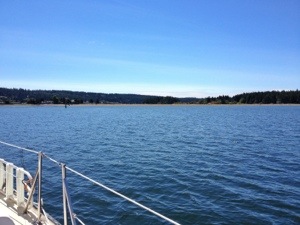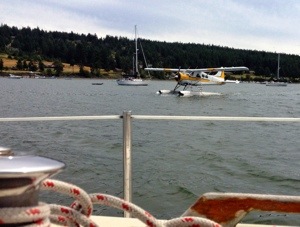 Can you see the entrance to the bay? We couldn’t either.
Can you see the entrance to the bay? We couldn’t either.
A little wind
After a very nice night at the marina in Friday Harbor, we planned on staying in the area so that we could get a little work done on Shannon.
The local marine service center was going to take a couple days to get a part we needed, but we didn’t want to hang out in the marina waiting on a part.
Being the intrepid cruisers that we are, we decided to find a spot outside the marina to drop anchor and happily wait for our part to come.
The marina has a 1pm check out time for guests. So, a little before 1pm, we packed up, cast off our lines and let the marina know that we were headed out of the slip.
A couple people suggested that the little bay just to the North of the marina was a good anchorage and that it was pretty well protected from the winds.
As we exited the marina and made our left turn to head into the bay, we quickly realized that we weren’t the only ones that had that idea. The little bay was packed.
Normally, this isn’t a problem. However, this bay is about 50 feet deep.
Now, that might not seem like a lot, but here is the problem. For an anchor to hold well, it must have between 5 and 7 times the depth in rope. So our 50 foot deep bay would need between 250 and 350 feet of rope. This allows the pull of the rope to be almost horizontal against the anchor, preventing it from pulling out of the bottom.
With the bay full of boats on mooring balls and anchors, there was no way we could put out that kind of line on the anchor.
So, we dropped anchor and let out about 150′ to see how it would do.
Nope, the first big gust of wind had us dragging the anchor along the bottom.
We could tell we were dragging because the boat that was behind us was quickly getting way too close for comfort!
Now comes the second big problem with trying to anchor in a deep bay.
Our anchor, like most, has a length of chain that roughly equates to the boat’s length between the rope and anchor. This helps keep the first 35′ of rode (everything between the boat and anchor) down low and pulling horizontally.
When the bottom is more than 35′ deep, pulling up the anchor means that I have to lift both the chain AND anchor all the way up from the bottom.
This gets heavy. Quickly.
Now, when we have to raise and lower the anchor over and over again in a short period, this gets downright ugly.
So, after the fifth attempt at finding a place that would hold us against the heavy gusts that were coming in that day, we decided to bag it and head back into the marina.
We accepted defeat, stowed the anchor and headed back into the marina.
Fortunately the marina hadn’t filled up yet and we got a slip assignment. Little did we know that we were lucky to have gotten one as the other big marina, Roche Harbor was being partially evacuated due to a big boat fire. Many of the displaced boats were heading to Friday Harbor for the night.
We learned two big lessons that day.
First, we learned that we need to always check the weather before leaving our current location. It wasn’t until we were fighting wind and waves did Kelly make the observation that neither of us bothered to check the weather forecast before we headed out. Oops.
The second big lesson was that if an anchorage looks too crowded or too deep, then it probably is. Go somewhere else or be prepared to get a good workout and a poor nights sleep.
Fisherman’s Bay
With these two lesson in mind, we spent the rest of the day pouring over charts, our Waggoner’s Cruising Guide and and the weather forecast to determine where were going to go to run from the winds that were forecast to continue over the next 24 hours.
We decided on a little cove on Lopez Island called Fisherman’s Bay just about five miles away.
 It has an almost hidden entrance and a very narrow channel that winds its way back to a cozy, protected bay that has good anchoring, two marinas and as we found out, a lot of sea-plane traffic.
It has an almost hidden entrance and a very narrow channel that winds its way back to a cozy, protected bay that has good anchoring, two marinas and as we found out, a lot of sea-plane traffic.
If you’ve been following our story, you’ll recall that our depth gauge decided to retire about a month ago. I was debating between replacing it with a simple, numeric depth gauge and a more sophisticated GPS/Depth unit.
Well, I’ll tell you that I’m really happy I went with the GPS/Depth unit. The channel into the bay was only a couple of boat lengths wide and as we were coming in at low tide, only a couple of feet deeper than our keel.
With the help of the GPS/Depth display, we were able to make it into the bay without hitting anything. I’m not completely sure that I could say that if I didn’t have the moving map feature on the GPS.
Fisherman’s Bay has been nice so far, but it hasn’t been without its issues. At one point I had to grab a hold of another boat so that we didn’t hit it, and the toilet is now filling up with grass each time we flush it.
More on those next time.
Right after I posted this, we got a little more traffic…
